System National Rail Services 5 | Status Operational Opened 1988 | |
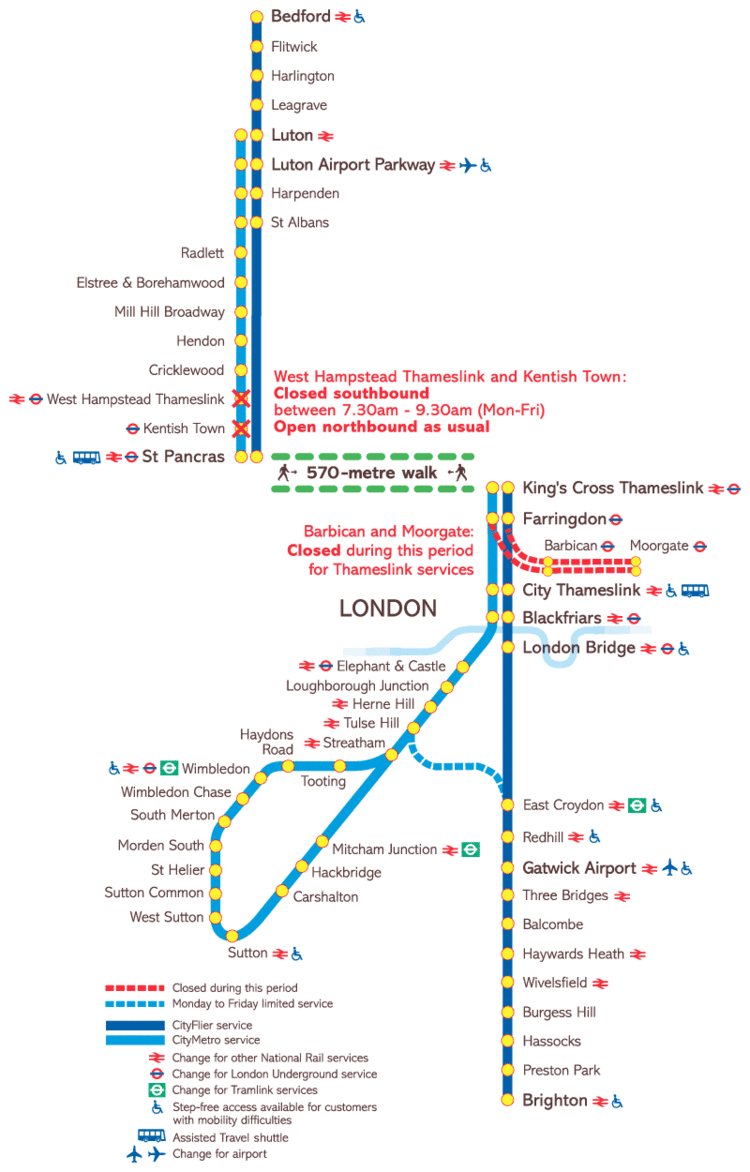 | ||
Type Commuter rail, Suburban rail Stations 68 (additional stations at peaks) Locale East of England, Greater London, South East England | ||
Thameslink is a 68-station main-line route in the British railway system running 225 km (140 mi) north to south through London from Bedford to Brighton, serving both London Gatwick Airport and London Luton Airport, with a suburban loop serving Sutton, Mitcham and Wimbledon and a suburban line via Catford and Bromley South to Sevenoaks. It opened as a through service in 1988 and by 1998 was severely overcrowded, carrying more than 28,000 passengers in the morning peak. Almost all the services are currently operated by Thameslink.
Contents
- Thameslink Class 700 Trip Review London Blackfriars to Cambridge
- Route
- Services
- History
- Thameslink Programme
- Rolling stock
- 2014 franchise
- Thameslink 2
- References
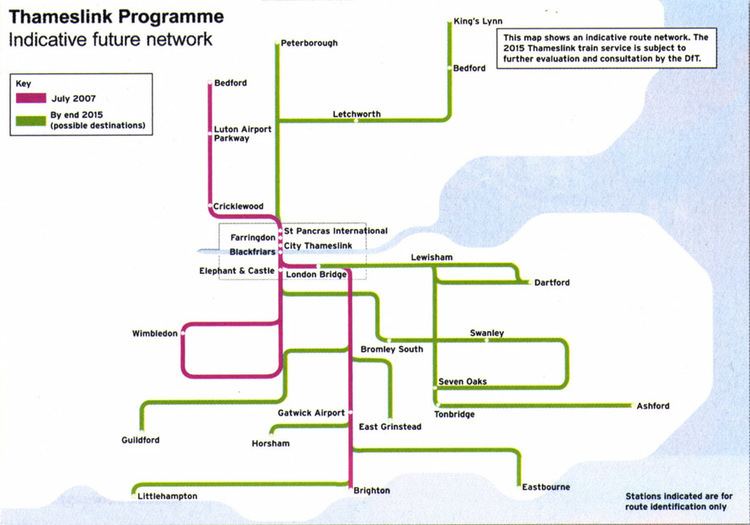
The Thameslink Programme is a major £5.5 billion scheme to extend the service to a further 100 stations and to greatly increase capacity on the central London section to accommodate more frequent and longer trains, scheduled for completion in 2018. In 2016, new Class 700 trains started operating on the route and are gradually replacing the Class 319, Class 377 and Class 387 trains which are being transferred elsewhere.
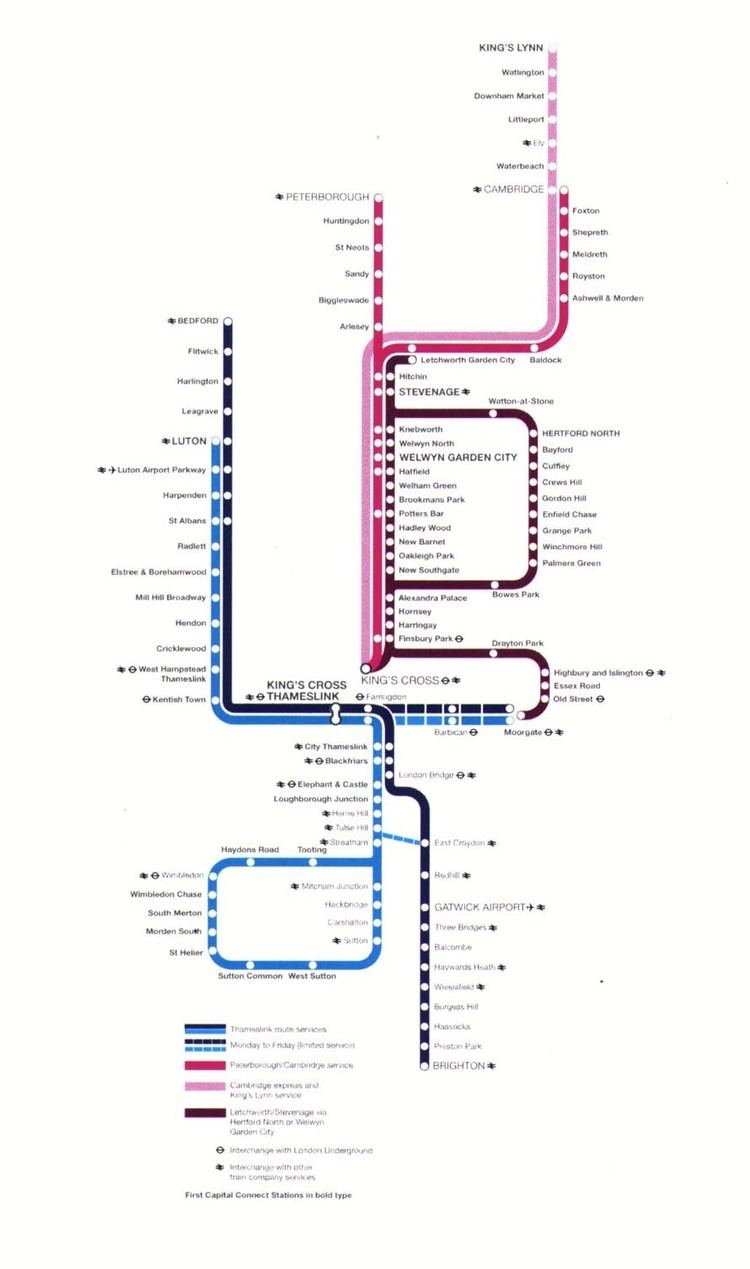
Thameslink Class 700 Trip Review | London Blackfriars to Cambridge
Route

Much of the route is over the Brighton Main Line (London Bridge branch) and the southern part of the Midland Main Line. There is also a suburban loop through Sutton and Wimbledon and a branch over the Catford Loop Line to Sevenoaks.

The route through central London is via St Pancras International for connections to Eurostar and the East Midlands; Farringdon, for London Underground Circle, Metropolitan and Hammersmith & City lines, and Crossrail from 2018; City Thameslink, which replaced the demolished Holborn Viaduct station and has a southern entrance serving Ludgate Circus; Blackfriars, for main-line rail services and the Underground District and Circle lines; and London Bridge for main-line links into Kent and Sussex and the Underground Northern and Jubilee lines. King's Cross Thameslink on Pentonville Road closed on 8 December 2007.
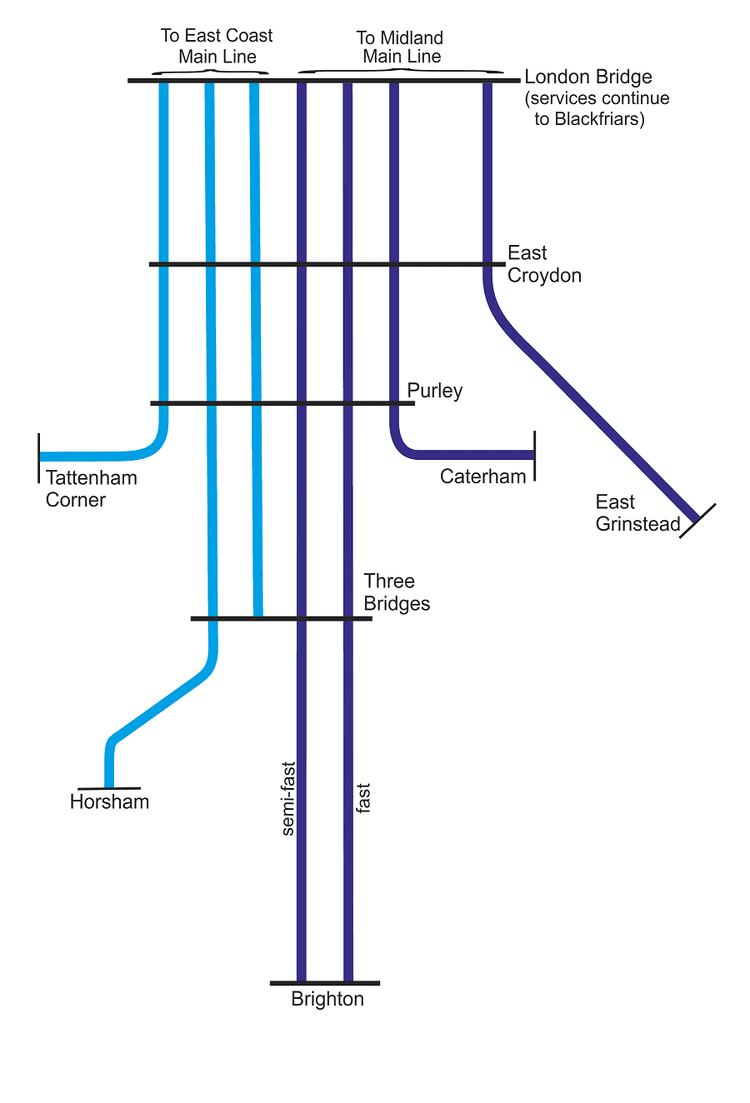
Trains operating the "main line" service (Bedford to Brighton) include first-class accommodation; those operating from Luton and St Albans to Sutton and Wimbledon are usually standard class only. When Govia operated the original Thameslink franchise these services were designated "Thameslink CityFlier" and "Thameslink CityMetro" respectively, but First Capital Connect dropped this branding. Govia Thameslink Railway now refers to these services as Route TL1 (formerly Route 6) and Route TL2/TL3 (formerly Route 7/8) respectively.
Services

The majority of fast trains run between Brighton and Bedford via London Bridge. Suburban Loop trains start at either Wimbledon or Sutton and call at all stations to Luton. Suburban trains from Sevenoaks call at all stations via Swanley and Bromley South, Catford and Peckham Rye, terminating at West Hampstead on weekdays, Blackfriars at weekends. Additional services to/from Bedford or Luton or St Albans start or terminate at St Pancras. There are also peak-only jointly operated Thameslink/Southeastern services between Rochester, Ashford International or Bearsted and Bedford. A 24/6 (there is no service overnight between Sunday and Monday) service operates between Bedford and Three Bridges serving Luton Airport Parkway and Gatwick Airport.
In trains per hour:

Peak services:
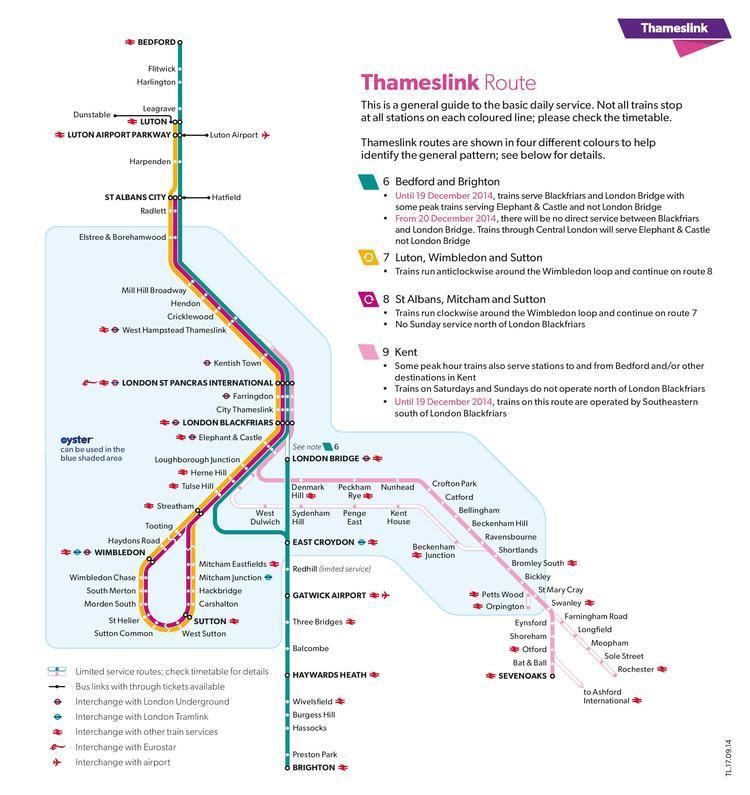
00:01–04:00:
History
Passenger services operated across London through the Snow Hill Tunnel from mid-Victorian times until World War I, when services terminated at Moorgate from the Midland line to the north, and at Holborn Viaduct from the south, at a time when most inner cross-London traffic had been lost to buses and trams. There were low-level platforms under the main part of Holborn Viaduct station known as the Snow Hill platforms: these can still be seen when leaving City Thameslink station travelling northwards.
On 14 June 1941 railwayman George Dow proposed in an article in the London evening newspaper The Star that new routes, in tunnel, be built from Marylebone south to Victoria, and from King's Cross south to Charing Cross. Both were to connect with a Paddington–Liverpool Street tunnel that he proposed, anticipating Crossrail by 40 years. He also proposed a north-east/south- west route from Liverpool Street to Charing Cross, all designed to give London a comprehensive main-line network of connections.
The Snow Hill Tunnel route remained open for cross-London freight trains until 1970, when the short section between Farringdon and Holborn Viaduct was closed.
Overhead Electrification, completed in 1982, allowed the northern section to run as the Midland City Line from Bedford via the Midland Main Line to St Pancras, and via the City Widened Lines to Moorgate.
The Snow Hill tunnel was re-opened by British Rail to passenger trains after 72 years, with Thameslink beginning in May 1988. On 29 January 1990 the section between Blackfriars and Farringdon was temporarily closed to permit the construction of a new alignment. The route through the site of the long-closed Ludgate Hill station, over Ludgate Hill to Holborn Viaduct was abandoned and demolished. The replacement route under Ludgate Hill was opened on 29 May 1990 by the Network SouthEast (sector of British Rail) concurrently with City Thameslink station, which was initially called St Paul's Thameslink but was renamed in 1991 to avoid confusion with St. Paul's station on the Underground (Central line), about 500 m (550 yd) away.
King's Cross Thameslink on Pentonville Road closed on 8 December 2007 when the Thameslink platforms at nearby St Pancras opened.
In the south the services divide: main-line trains run through London Bridge to East Croydon and Brighton, but the other route has a more convoluted history. In 1988–91 trains went via Bromley to Orpington and Sevenoaks, and via Herne Hill and East Croydon to Purley (off peak only). Later, non-Brighton trains ran via Elephant & Castle and Streatham to West Croydon, Carshalton Beeches, Sutton, Epsom, Leatherhead and Effingham Junction, to Guildford.
On the privatisation of British Rail, Thameslink was franchised to Thameslink, a subsidiary of Govia.
Around 1994 the second branch was cut back to West Croydon as this route crossed the commuter networks of what were to become several different rail companies, and rail privatisation made the route increasingly difficult to maintain.
Around 1995 the route was changed completely, with a route to Sutton via Mitcham Junction continuing on a loop to Wimbledon rejoining itself south of Streatham replacing the West Croydon service.
By late 1998, more than 28,000 passengers were carried at morning peak times.
From 1 April 2006 the franchise was taken over by First Capital Connect along with some services previously operated by WAGN. The branding of most trains, stations, and signs was changed to match the name of the new company, but City Thameslink and West Hampstead Thameslink were not renamed as Thameslink referred to the route. After criticism of the loss of the apt name for this group of routes, First Capital Connect's publicity began calling this set of services its "Thameslink route" to distinguish it from the former WAGN services.
On 14 September 2014, Govia Thameslink Railway took over operations from First Capital Connect with routes now branded as Thameslink and Great Northern.
Thameslink Programme
Following the success of the original scheme, plans were drawn up to upgrade the network to cope with the increasing passenger numbers that have led to severe peak-time overcrowding. Network Rail obtained planning permission and legal powers in 2006, funding was secured in July 2007 and construction began in October 2007. Plans included rebuilding the station buildings at Farringdon (in conjunction with the Crossrail project) and West Hampstead Thameslink, total rebuild of London Bridge and Blackfriars stations, two new underground platforms at St Pancras International, a new tunnel north of St Pancras International to the East Coast Main Line to allow through services to Peterborough and Cambridge in 2017, and platform lengthening, now being completed. A new 8 and 12 carriage fleet of Class 700 trains began entering service in 2016.
The London and South East Route Utilisation Strategy published in July 2011 lays out a provisional 24tph timetable. South of London it would provide four trains to Brighton (one semi-fast, one stopping) and two each to Three Bridges, Horsham, East Grinstead, Caterham, Tattenham Corner, Tunbridge Wells, Ashford International, Maidstone East, Sevenoaks and Bellingham. North of London there would be eight semi-fast trains to Bedford, four stopping trains to St Albans, two stopping and two semi-fast trains to Luton, two semi-fast trains to Peterborough, two semi-fast trains to Cambridge and four stopping trains to Welwyn Garden City.
Below is a provisional timetable for Thameslink once the upgrade is complete.
Rolling stock
Rolling stock used on Thameslink includes the 86 Class 319 trains built by BREL between 1987–1988 and 1990. These are electrically powered dual-voltage four-car units rated to carry 289, 308 or 319 passengers. They use 25 kV AC overhead power north of Farringdon and 750 V DC third rail to the south. Four Class 319 trains had been transferred from Southern in December 2008 and the last four followed in March 2009, from which point they were all on Thameslink.
First Capital Connect acquired 23 four-coach Class 377 sets during 2009 on sublease from Southern, for the Thameslink route for additional capacity and to allow some of the Class 319 trains to be released for the Catford Loop service to Sevenoaks, now jointly operated with Southeastern under Key Output 0 of the Thameslink Programme.
Class 317 units built in the early 1980s were still in use when services into Moorgate ceased in March 2009: the last timetabled service ran from Farringdon to Bedford on 9 October 2009.
New energy-efficient Class 700 trains will provide an additional 14,500 seats and will be delivered from 2015 to 2018. Siemens Mobility was named preferred bidder on 16 June 2011, with the Desiro City train family. The contract was signed in June 2013 for 1140 carriages, with 55 twelve-car and 60 eight-car trains. The depots are at Hornsey and Three Bridges. The Three Bridges depot opened in October 2015 and the first trains entered service in spring 2016.
Due to delays in the new Class 700 fleet, the DfT and Southern ordered 116 electric dual-voltage 110-mile-per-hour (180 km/h) carriages (29 trains) with the option for another 140 carriages (35 trains). The tender for the new Class 387 trains was won by Bombardier and the first set entered service in December 2014, with all in service by May 2015. These trains will move to Great Northern once the Class 700 is fully delivered. All rolling stock used on Thameslink is electrically powered dual-voltage units using 25 kV AC overhead power north of Farringdon and 750 V DC third rail to the south.[1]
2014 franchise
The invitation to tender for the Thameslink Southern & Great Northern franchise was expected to be issued in October 2012, with the contract commencing in September 2013. On 29 March 2012, the Department for Transport announced Abellio, FirstGroup, Govia, MTR Corporation and Stagecoach Group had pre-qualified to bid for the franchise.
Due to problems with the InterCity West Coast tendering process, the process was delayed, with the new franchise delayed until September 2014. The new franchise includes the South Central franchise currently operated by Southern and certain routes from the Integrated Kent Franchise currently operated by Southeastern.
On 23 May 2014, it was announced that the franchise has been awarded to Govia Thameslink Railway. The new Thameslink Southern & Great Northern franchise will include both the Thameslink Great Northern and South Central franchises.
Govia Thameslink Railway began operations on 14 September 2014, with the former First Capital Connect routes branded as Thameslink and Great Northern.
Thameslink 2
‘Railfuture’, an organisation campaigning for better rail services for passengers and freight, has proposed an additional north-south route, connecting the Brighton Main Line to routes north of London, via East Croydon, Lewisham, Canary Wharf, and Stratford.
